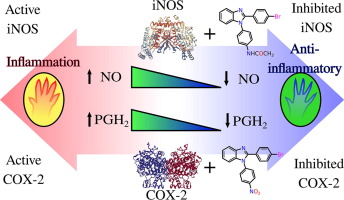Bioorganic & Medicinal Chemistry ( IF 3.5 ) Pub Date : 2020-03-21 , DOI: 10.1016/j.bmc.2020.115427 Mónica I. García-Aranda , Jazmin E. Gonzalez-Padilla , Carlos Z. Gómez-Castro , Yolanda M. Gómez-Gómez , Martha C. Rosales-Hernández , Efrén V. García-Báez , Marina O. Franco-Hernández , José L. Castrejón-Flores , Itzia I. Padilla-Martínez

|
Being the base of several non-communicable diseases, including cancer, inflammation is a complex process generated by tissue damage or change in the body homeostatic state. Currently, the therapeutic treatment for chronic inflammation related diseases is based on the use of selective cyclooxygenase II enzyme, COX-2, inhibitors or Coxibs, which have recently regained attention giving their preventive role in colon cancer. Thus, the discovery of new molecules that selectively inhibit COX-2 and other inflammatory mediators is a current challenge in the medicinal chemistry field. 1-Phenylbenzimidazoles have shown potential COX inhibitory activity, because they can reproduce the interaction profile of known COX inhibitors. Therefore, in the present investigation a series of 1,2-diphenylbenzimidazoles (DPBI) with different aromatic substitutions in the para position were synthesized and their interaction with COX-2 and nitric oxide synthase, iNOS, was determined in silico, in vitro and in vivo. Compound 2-(4-bromophenyl)-1-(4-nitrophenyl)-1H-benzo[d]imidazole showed the best inhibition towards COX-2, while compounds N-(4-(2-(4-bromophenyl)-1H-benzo[d]imidazol-1-yl)phenyl)acetamide and N-(4-(2-(4-chlorophenyl)-1H-benzo[d]imidazol-1-yl)phenyl)acetamide diminished the production of NO in vitro. Additionally, they had a significant anti-inflammatory activity in vivo when given orally.
中文翻译:

通过使用1,2-二苯基苯并咪唑药效团靶向COX和iNOS酶来抗炎和抑制一氧化氮的产生
作为包括癌症在内的几种非传染性疾病的基础,炎症是由组织损伤或体内稳态变化引起的复杂过程。当前,用于慢性炎症相关疾病的治疗方法是基于选择性环氧化酶II酶,COX-2,抑制剂或Coxibs的使用,最近它们因在结肠癌中的预防作用而重新受到关注。因此,发现选择性抑制COX-2和其他炎性介质的新分子的发现是药物化学领域中的当前挑战。1-苯基苯并咪唑类化合物具有潜在的COX抑制活性,因为它们可以重现已知COX抑制剂的相互作用情况。因此,在本研究中,一系列1,2-二苯基苯并咪唑(DPBI)具有不同的芳族取代基。合成了对位,并在计算机,体外和体内测定了它们与COX-2和一氧化氮合酶iNOS的相互作用。化合物2-(4-溴苯基)-1-(4-硝基苯基)-1 H-苯并[ d ]咪唑显示出对COX-2的最佳抑制作用,而化合物N-(4-(2-(4-溴苯基)- 1 H-苯并[ d ]咪唑-1-基)苯基)乙酰胺和N-(4-(2-(4-氯苯基)-1 H-苯并[ d ]咪唑-1-基)苯基)乙酰胺减少了产量体外NO含量的研究。另外,当口服时,它们在体内具有显着的抗炎活性。


























 京公网安备 11010802027423号
京公网安备 11010802027423号